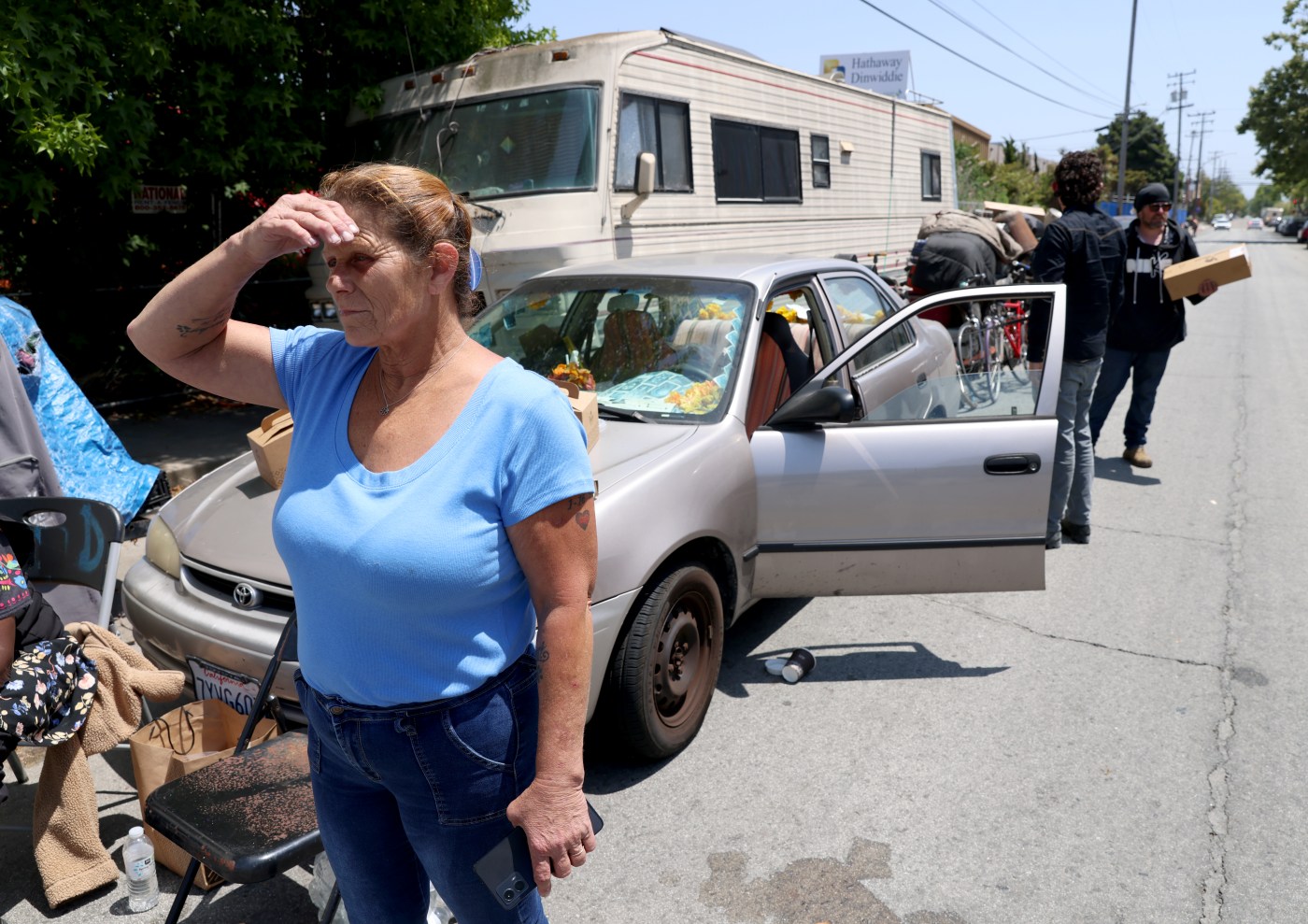By Lee Romney, CalMatters
Susanna’s Sacramento County home bears the scars of her daughter’s mental illness. There is the lump on the wall near the entryway, patched after the girl, now 17, busted through the drywall. On a recent day, a double door in a bulky box awaited installation — to replace the splintered entry to the bedroom Susanna shares with her husband.
The rages began when the girl was in fourth grade, said Susanna, whose last name CalMatters is withholding to protect her daughter’s identity. In recent years, the family has resorted to calling 911. Susanna said she has sustained a black eye and other minor injuries while fine-tuning her daughter’s medications, which include an antipsychotic. Mostly, she said, they’ve called in desperation for help when they had nowhere else to turn.
Related Articles
‘Reckless’: US stiffs Bay Area schools on $14.5 million in mental health grants
Opinion: Why don’t we see older adults with autism? It’s history, not mystery
Mental health services lacking in immigration detention centers, California report finds
Letters: Death of our republic is the world’s loss
Judge orders involuntary medication of California conspiracy theorist charged with killing his 2 kids in Mexico
“They have been able to assist, whether it be taking her to the hospital for a 5150 hold, or just de-escalating the situation,” said Susanna, using the Welfare and Institutions Code shorthand “5150” for an involuntary psychiatric evaluation, due to danger to self or others, or grave disability.
Starting early last year, though, Susanna noticed that law enforcement “seemed more disinterested in those calls.” Then, as another crisis unfolded Feb. 7, the Sheriff’s Department made it clear they would not be coming out at all.
The 911 audio and a summary log lay out the scene: Susanna’s husband was trying to sleep when the daughter, who was on probation, barged into the bedroom just before midnight, spit in his face, and “threatened to stab me and kill me.” A dispatcher asked if the daughter had “mental health issues;” the husband said she did.
What the couple didn’t realize: Due to a recent policy change, that detail kicked the call up to a supervisor — and ultimately left Susanna and her family to fend for themselves.
Susanna said she saw her daughter heading back to the bedroom with a kitchen knife. She locked the door and was leaning against it to keep it from giving way under her daughter’s blows as her husband spoke to the dispatcher. The four-minute conversation ended when the dispatcher promised to “have someone out there.”
Instead, a supervisor called the husband back. A call log states that they discussed the girl’s “extensive” mental health issues and history of assault as the screaming and pounding continued. The supervisor then suggested the couple stay in the locked bedroom.
“No crime,” the call log concludes. Sacramento Sheriff’s Office “not responding.”
Why a sheriff pulls deputies back on mental health calls
In early January, Sacramento County Sheriff Jim Cooper met with county behavioral health and emergency medical response partners and dropped a bomb. His department would no longer respond to mental health crisis calls unless a crime had occurred, was in progress, or someone other than the person in crisis was deemed to be in imminent danger.
While he’d been pondering the pullback for a year, he told them, what pushed him to act was a 9th U.S. Circuit Court of Appeals ruling that he believes heightens his officers’ liability on non-criminal mental health calls.
“Law enforcement officers are not trained mental health professionals,” Cooper announced in a news conference a month later. “We wear the badge; we carry the gun. We deal with crime – not mental health crises.” When his department responds to calls that do involve crimes, he added, they will be treated as a “major event” — suggesting they might result in arrest rather than transport for care under the 5150 code. Cooper has called the change a “hard reset” — one he knew would be controversial.
Then-Assemblymember Jim Cooper announces his campaign for Sacramento sheriff during a press conference in Sacramento on Feb. 10, 2022. Cooper went on to win the election. Photo by Rahul Lal, Sipa via AP Images
Yet these issues have challenged policymakers for more than half a century: Because mental illness isn’t a crime, when should law enforcement be involved, if at all? Who is best suited to safely de-escalate a mental health crisis and coax a person to accept care? And what if that person won’t — or due to the nature of their psychosis or substance use cannot — agree to go voluntarily? Who will transport them for involuntary psychiatric holds?
Families of seriously ill loved ones say they’ve clamored for answers to that latter question for some time now. One desperate mother whose son recently needed to be taken to the hospital for urgent evaluation resorted to hiring a bounty hunter.
California under Gov. Gavin Newsom has taken bold steps to broaden access to care for people with untreated psychotic illnesses and substance use disorders— including expanding the legal definition of “grave disability” under the 5150 code. That law is expected to compel more people to receive treatment. Its success depends in part on transporting those in crisis for evaluations — even if they won’t go voluntarily.
Just a week after Sacramento County implemented the new law, Sheriff Cooper informed his partners of his policy shift. Now, as he publicizes his position at a law enforcement conference and webinar and through his own podcast, some other agencies are following his lead.
Cooper cites his eight years in the state Assembly as instructive. There, he said in an interview, “We always heard, hey, we don’t want law enforcement responding to mental health calls. I come back as sheriff, and I’ve seen a lot of bad outcomes, in California and across the nation…Sometimes, introducing a badge and gun can really make it go sideways.”
Cooper was sworn in two months after a fatal deputy-involved shooting of a man in psychosis whose wife called for help as he threatened to hurt himself with a machete. He died 23 seconds after the lone deputy arrived. Last March, another such shooting took the life of a mentally ill man whose sister called 911 as he cut himself in the bathtub with a knife. Litigation is pending in both cases.
A Sacramento County Sheriff’s Department vehicle outside of a church where a man shot dead four people, including three of his children, before turning the gun on himself on Feb. 28, 2022. Photo by Andri Tambunan, AFP via Getty Images
Susanna had seen Cooper’s announcement on TV. Three nights later, as she braced herself against the bedroom door, it didn’t cross her mind. Instead, she was shaken by the lack of response by law enforcement to what felt like a volatile and potentially dangerous situation.
“At that moment, you’re just thinking, ‘We need to get help here now, before this escalates further,’” she said. “Who is going to assist my family in these situations, and not only my family, but other families like mine, whose child might be more aggressive or might actually kill them or hurt them very badly? Who is going to step in and stop that before it’s too late?”
When other responders want a police backup
Like many jurisdictions, Sacramento County has been pushing to reduce the role of law enforcement in behavioral health crises and avoid traumatic hospitalizations — or arrests — when possible, instead helping people develop safety plans and plugging them into outpatient care.
Still, county Behavioral Health Services Director Ryan Quist said law enforcement will always be critical to the “system level response.” His civilian crisis teams, made up of a clinician and a peer, cannot engage without backup in situations where people in crisis have weapons or are particularly volatile — even if they are only threatening to harm themselves. And, he said, when clinicians determine an evaluation for a psychiatric hold under the 5150 code is necessary, they cannot detain or transport those too agitated or ill to consent to go.
“Behavioral health doesn’t have that training skill set, or desire, to actually put hands on somebody and make them go somewhere,” said Quist. Beyond that, because they are not peace officers, “legally speaking, that’s assault.”
County leaders are scrambling to assess the damage. In emotional public testimony in February before the county’s Sheriff Community Review Commission — an advisory body that has no control over the elected official’s policies — Sacramento Metropolitan Fire District officials said Cooper’s department had denied 14 of their 21 requests from the field for backup over the previous 11 days.
Each “presents a safety factor for the community that’s going to at some point either get somebody really hurt or killed,” Battalion Chief Parker Wilbourn told the commission, noting that close collaboration on such calls is the gold standard. “That’s why we heavily rely on our law enforcement brothers and sisters to have our backs like we have theirs.”
Dispatch records and incident reports shared in response to a CalMatters public records request show that, of those 14 cases, Metro Fire responders were able to get three people experiencing psychosis to agree to be taken to the hospital. In seven other cases, they were either unable to evaluate people in crisis due to safety concerns or unable to transport those who were uncooperative.
Two calls involved a man wearing an ankle monitor and threatening his landlord’s son over an attempted eviction. Firefighters first came to the scene to evaluate the landlord for high blood pressure — and called for backup because the tenant’s threats, “confused speech, unsteady gait and erratic behavior” concerned them. “Situation becoming unstable,” the log notes. Yet a sheriff’s sergeant who waited nearby made it clear: “Won’t resp unless a crime occurs.”
With no help on the way, the log continues, the landlord and two other residents “fled [the] scene” in fear. Five hours later, the tenant called 911 to say that he was bleeding from an injury, and planned to shoot himself and set the house on fire. Rancho Cordova Police, staffed by the Sheriff’s Department under a longstanding contract, declined to respond. Fire responders waited outside, checking for signs of smoke, but did not feel safe to enter.
“I want you to put yourself in the shoes of the folks living next door,” Wilbourn told the commission. “They were sound asleep at three in the morning when this was taking place. Their kids, their families could potentially have been in harm’s way.”
In Susanna’s case, neither her husband nor the Sheriff’s Department requested emergency medical personnel. Her daughter did calm down, eventually. Not long after the incident, she got off probation — something that would not have happened if she had been criminally charged for the spitting or threats that night.
Sheriff Cooper has stressed that “being mentally ill should not be a crime. Someone shouldn’t have to be arrested and go to jail to get help.” But with no transport options for those who won’t or can’t consent to psychiatric evaluations that outcome can become inevitable.
Despite a follow-up with her psychiatrist, Susanna said, her daughter’s mental health worsened, bringing deputies to the house three times earlier this month. All involved escalating disputes with a younger brother, the Sheriff’s Department confirmed. Once, a mail carrier dialed 911 as he heard yelling and furniture breaking.
At the last call, on April 16, they took her into custody. Susanna had locked up the kitchen knives. But after assaulting her younger brother, she said, her daughter grabbed a fireplace poker and chased him with it, threatening to kill him. Her daughter is now in juvenile hall facing charges of making terrorist threats.
“Probably juvenile hall isn’t where she needs to be,” said Susanna, who is pressing social workers to place her daughter in a treatment facility. “She would be better off at a hospital, but (deputies) don’t take them anymore. They no longer provide that service.”
On April 14, the Sheriff’s Department confirmed, a mail carrier dialed 911 when he heard Susanna’s daughter inside the home yelling and breaking items, including this door. Listen to Susanna describe why “it’s scary when you’re in that situation.” Photo courtesy of Susanna.
An alternative to law enforcement is ideal, said Dominic Sisti, a bioethicist who directs the Scattergood Program for the Applied Ethics of Behavioral Health Care at the University of Pennsylvania. “But when you have somebody who is potentially violent towards themselves or others, I don’t see any way around having somebody there who has the training to manage that situation from a safety perspective, not just a health care perspective.”
In the long term, he said, “these individuals are going to get sicker. They’re going to probably get more agitated. The families are going to suffer and we’re going to see worse outcomes.”
Among the most effective responses in volatile situations, experts say, are co-response teams, made up of a clinician who rides shotgun with law enforcement. In an interview, Sheriff Cooper described the two teams his department had been operating as “incredibly successful” — though they would not have been available at midnight, when Susanna’s family arguably needed them most. Now, given Cooper’s policy change, the behavioral health director has assigned those clinicians to other law enforcement agencies in Sacramento County.
Cooper’s stance is nevertheless resonating with agencies who say they’ve been overly burdened with responsibility for the crisis of serious mental illness ever since California’s Lanterman-Petris-Short Act, which created the 5150 civil code, went into effect in 1969. All states now have similar laws.
“We’re not in the profession of white coats coming out to take somebody to the hospital,” said Orange County Sheriff Don Barnes, president of the California State Sheriffs Association.
Barnes said he has long been committed to getting his department “out of social work.” Last year, his dispatchers began vetting non-criminal mental health calls, diverting 80 to other resources. Now, given his own heightened liability concerns, he’s taking it further. The 5150 code, he said, states that law enforcement “may” — not “shall” — initiate involuntary psychiatric holds, detain, and transport for evaluation those who appear to meet criteria.
“We are going to be considering what is the best alternative approach,” Barnes said, “and some of that might be saying, ‘I’m sorry Mr. and Mrs. Jones, but you’re going have to deal with your son a new way.”
The court ruling that set police on edge
The 9th Circuit ruling cited by Cooper, Scott v. Smith, resulted in the loss of “qualified immunity” for two Las Vegas police officers whose actions led to the death of an unarmed mentally ill man. The decision, which exposes the officers to personal liability, has without question troubled law enforcement.
Roy Anthony Scott called Las Vegas police for help on the early morning of March 3, 2019, believing there were people inside his home plotting to harm him. The two responding officers persuaded him to come outside, where he obeyed commands and handed over two weapons. Bodycam footage reveals that Scott told the officers he had schizophrenia, that he was too paranoid to turn around and face the wall. Twice, he asked, “Can you just put me in the car please?”
When the officers grabbed Scott’s arms to restrain him on a mental health hold, court records show, he flailed and begged them to stop. Instead, they took him to the ground and placed him on his stomach. One applied bodyweight to Scott’s neck and chest “for about one to two minutes,” while the other held his legs.
In keeping with U.S. Supreme Court precedent, the three-judge panel balanced the type and level of force used on Scott against the nature of his crime and threat he posed. Since Scott was mentally ill, not suspected of a crime, unarmed and posed no risk to officers or anyone else, “the government’s interest in applying force was limited,” they wrote, adding that any reasonable officer would have known that bodyweight compression to the neck and chest “created a serious risk of asphyxiating Scott.”
Furthermore, they noted, the officers failed to attempt “less intrusive alternatives” such as “verbal de-escalation,” waiting for backup to execute a “safer ‘team takedown,’” or for emergency medical personnel “to execute a ‘soft restraint.’”
Las Vegas police have asked the U.S. Supreme Court to review the case.
Sheriff Cooper’s take is blunt: Any level of force on a non-criminal mental health call could lead an officer to ruin. “Someone doesn’t want to go, you’ve got to wrestle them on the ground, something happens, maybe they have a cardiac arrest. You lose qualified immunity,” he said. “Who would want to have a job where you’re doing what’s right, something happens, and you lose your house and everything you’ve ever earned?”
The law firm that provides legal advice to the California Police Chiefs Association and the California State Sheriffs Association disagrees.
The court came to its conclusion by weighing all “facts and circumstances before it,” as they would in any Fourth Amendment excessive-force case, attorney James R. Touchstone of the firm Jones Mayer concluded in a Feb. 12 “client alert memorandum” addressed to “all Sheriffs and Chiefs of Police.”
“Although many may disagree with the Court’s determination, including this author,” Touchstone wrote in the seven-page memo obtained by CalMatters, “it does not stand for the proposition that qualified immunity is unavailable to law enforcement officers” who are responding to non–criminal mental health calls and may need to be detained and transported to the hospital on an involuntary psychiatric hold.
A commentary posted to Police1, a national online law enforcement resource, was more pointed. Given law enforcement’s longstanding role in psychiatric detention and transport, ample training opportunities, and best practices based on partnerships with clinicians and emergency medical responders, Cooper’s policy change, it states, “while well-intentioned, is simply wrong.”
Desperate enough to hire a bounty hunter
Patricia Wentzel, who serves on Sacramento County’s mental health board, has blasted Cooper’s stance as discriminatory, given that law enforcement responds to other non-criminal crises involving people with dementia or developmental disabilities. “I don’t think he feels a responsibility to this group of people,” she said. “That’s the impression conveyed by this decision.”
Yet across the state, parents with severely mentally ill loved ones living at home aren’t exactly surprised. Katy Polony, a family advocate on an Alameda County mobile crisis team, said criminalization has often been the only option.
“‘Get a restraining order. Then we will forcibly go in. We’ll get that person out of there, and we’ll put them on the street,’” Polony said. “That’s what families have been told to do, forced to do.”
Indeed, Susanna and her husband say that was the sheriff supervisor’s final suggestion to them on Feb. 7 before he hung up — that if they feared the daughter they should get a restraining order when she turns 18.
While restraining orders are civil, violating them is a crime.
Last year, Polony helped organize a group of parents from Fremont to press police to engage more on behavioral health crisis calls. After Cooper went public with his policy, she began hosting bimonthly Zoom calls to gather family input statewide. That’s where Mary Palafox first shared her story.
For the past 14 years, Palafox has served as private conservator to her son, deemed gravely disabled by schizophrenia that took hold in his early 20s. Many parents don’t want the responsibility, or can’t afford to take it on. But Palafox has means. Her son, an artist who loves animals, thrives at the family’s Orange County home when he is stable.
As her son’s conservator, Palafox has a standing court order to have her son evaluated at a hospital when she sees fit. When he has been too ill to consent to go voluntarily, law enforcement has helped coerce him onto an ambulance gurney. Until recently.
Five years had passed since her son’s last hospitalization, but after stopping his medication, he retreated deep into his illness, she said. In early January, Palafox said, his doctor urged her to get him to the emergency room. Each serious bout of psychosis causes damage to the brain that can lead to neurocognitive deficits. As a nurse and longtime mental health advocate and educator, Palafox knew “it was a medical emergency.”
Mary Palafox at her Orange County home on April 1, 2025. Trying to get care for her adult son in crisis, she was told “You just need a big guy to come in and help you.” Photo by Jules Hotz for CalMatters
But, despite her legal paperwork, two law enforcement agencies declined to touch her son. Palafox first called 911 as he sat in florid psychosis in a Tustin restaurant. When he emerged, Tustin police officers “watched him walk away. They said that they cannot engage with him unless he’s committing a crime,” she said, “that they no longer help transport or ‘lay hands’ on anybody who has a mental illness.”
Palafox tried again a few days later as her son hid in a backyard shed at home, in psychosis. The Orange County Sheriff’s Department serves her unincorporated neighborhood, and deputies arrived along with a fire truck and ambulance, just as they had five years earlier. This time, she said, they told her they would not go into the backyard to evaluate her son for fear of escalation. They would only take him to the hospital if he climbed onto the gurney himself.
“It would have had to be completely self-directed, and he was too symptomatic to understand that he needed to go,” Palafox said. “If he was capable of doing that, I would have taken him in my own car!”
Desperate, Palafox reached for her phone. “You just need a big guy to come in and help you,” mused one attorney who handles county conservatorships but had never heard of such law enforcement refusals for conservatees. A call to a friend turned up a name. The man’s line of work: “Fugitive recovery.”
The first image that popped into Palafox’s head was “Dog the Bounty Hunter,” the longhaired reality TV phenom. But the man who took her next call was professional and thorough. He reviewed her legal paperwork, and informed the sheriff’s department and UCI Medical Center security of his plans. When he showed up at Palafox’s place with a partner a few hours later, they went straight to the shed, where her son was still huddled.
“He was kind of hanging on to things, not wanting to leave the shed,” said Palafox, who commended the men for their kindness, “but then they just picked him up.” With the aid of soft restraints, they “took him and put him in their truck.”
Palafox followed, informing the mental health liaison at the emergency room of their progress as she drove. They were directed to the ambulance bay – and, to the amazement of hospital staff who gathered to witness the unprecedented delivery, it was done. Palafox said her son was so ill he remained hospitalized for three months.
Palafox paid $1,700 for the intervention, a fee she knows many families can’t afford. Neither do most have standing court orders to have their loved ones evaluated. But they share a problem.
First: Decorations in Mary Palafox’s garage, in Orange County on April 1, 2025. Last: Leo sits on the “catio,” a screened-in patio with cat toys, at Mary Palafox’s home on April 1, 2025. Mary’s son has two cats and loves animals. Photos by Jules Hotz for CalMatters
“I’m not certain if that gap needs to be filled by our police and by our sheriff’s department,” she said. “I understand their scope of practice is people committing crime. It’s just that the transport need is still there.”
When asked about Palafox’s experience, Orange County Sheriff Barnes returned to the distinction in the 5150 code — “may” versus “shall.” Just because she has a standing court order, he said “it does not by default mean we have to provide services. We are going to be taking a different review of our obligation to intervene — and in many cases there isn’t any.”
The Del Norte County Sheriff and Crescent City Police Department have embraced more sweeping policies similar to Cooper’s, telling local media they will no longer respond to non-criminal mental health crisis calls. Barnes said he’s certain others will follow.
Dial 911: Breaking ‘the habit that people got into’
There is little disagreement on the need to minimize the role of law enforcement in mental health crises. Alternatives that center dignity, self-directed care and lasting therapeutic relationships, while not widespread, are more available than ever.
“The police were on the front lines for decades. And then the jails and the prisons were on the front lines. And now, in the last five years or so, we’re trying to move away from that,” said Yolo County Superior Court Judge Samuel McAdam, who teaches a course at UC Davis Law School on “mental health and the courts” that dives deep into the evolution of crisis response. “We’re trying to create a transformation in our society where everyone is taking responsibility, and the police are there for narrow important cases.”
In many ways, Sacramento County is well-positioned to deliver. It was among the first in California to operate a 988 suicide and crisis lifeline — created by Congress in 2020 to reduce reliance on police. Cooper’s policy shift has now fast-tracked efforts to integrate 911 and 988 technologies, so dispatchers can make a smooth handoff and track that data.
Last month, 988 counselors fielded 1,826 calls countywide, resolving more than 90% by phone, according to a spokesperson for WellSpace Health, which runs the service. In 16 cases, counselors determined there was an immediate threat to life so called out law enforcement or fire responders. They referred 154 calls to Sacramento County’s in-person “Community Wellness Response Teams.” Made up of a behavioral clinician and a peer with lived experience, they operate 24/7.
Due to critical Medi-Cal funding secured by California two years ago, similar teams are scaling up across the state.
Meanwhile, two specialized teams run by the Sacramento Metropolitan Fire District, which pair a nurse practitioner or physician’s assistant with a paramedic, have been ramping up service to people in behavioral health distress. And, though Cooper’s teams have been sidelined, Sacramento County social workers have been riding shotgun with a handful of police departments on those “co-response” teams.
Licensed clinician Ernesto Alvarado talks to a man about his partner’s mental health struggles in Penn Valley, California on March 15, 2022. Alvarado is part of Nevada County’s Mobile Crisis Team. Photo by Max Whittaker for CalMatters
Kaino Hopper is a mental health advocate and mother of a severely ill adult daughter, has helped develop the civilian crisis teams. She said she was appalled by the unilateral nature of Sheriff Cooper’s decision. Like others, she believes close collaboration among law enforcement, behavioral health and fire responders must be restored. Yet for “families like mine,” she told the Sheriff Review Commission in March, there’s a silver lining.
“We’re not entirely disappointed. Why? Because it’s made people need to know who we are and what we are,” Hopper said of 988 and the all-hours crisis teams. “We’re getting the flyers out there, grassroots, one-on-one,” at Sacramento Kings games, concerts and other public gatherings.
Dialing 911 for every mental health crisis “was the habit people got into,” Hopper told the commission. Now, she said, “our response teams are able to do 90% of the de-escalation necessary. Families are happy, support people are happy, even the person in distress is happy to have a non-uniformed person come out with an open-ended time frame.”
McAdam, the Yolo County Superior Court judge, said these types of innovations should reduce the number of calls on which police are asked to assist. But they’ll always be involved when serious crimes occur. They should also be counted on to respond when civilian partners believe they can’t safely handle a situation, or need help to safely evaluate and transport on 5150 holds. That’s why training is critical.
Team tactics ‘when things are chaotic’
A 2015 state law mandates some crisis intervention training for law enforcement, to help them understand and identify mental illness and best communicate with those in crisis. A Sacramento County Sheriff’s spokesperson said the department is in compliance and then some. Others have taken their training much further.
San Francisco Police Lt. Donald Anderson instructs outside agencies across the country on tactics that reduce risk and liability. As the head of his department’s Crisis Intervention Team, he coordinates with emergency medical responders and public health social workers to triage cases of people in distress, among them those who generate multiple 911 calls per week or day. “Then we can work with one another to see what else can we offer to get them to the resources they need,” Anderson said in an interview. “We tag team it.”
San Francisco Police Lt. Donald Anderson teaches a day-long course on crisis intervention tactics at the city’s police academy on March 4, 2025. Photo by Lee Romney for CalMatters
More than three-fourths of the department’s patrol officers have received 40 hours of voluntary crisis training, co-taught by clinicians and mental health advocates, with input from peers. But the game changer, a change in field practices that drove use of force on crisis calls down by 68% over a four-year period, was a different type of training — a mandatory one that Anderson helped craft.
Anderson is stocky with an enthusiastic teaching style and a passion for jiu jitsu. A prominent tattoo on his forearm honors the traditional Japanese code of ethics and conduct followed by samurai warriors. On a recent early morning with fog settled on the city’s hilltop police academy, he welcomed a group of officers to his 10-hour class. For years, he told them, those who’d sought out voluntary trainings wound up on crisis calls with partners who hadn’t. That was a problem. Behind it was a bigger one: “We weren’t talking about the actual tactics of law enforcement.”
“When things are chaotic and you have an individual running around in the middle of downtown, maybe with a knife, shouting and screaming, and you’re trying to control the public and trying to engage with this individual, tactically how does that look?” Anderson asked his students.
In 2016, Anderson and his then-supervisor traveled to Seattle to learn about that city’s “team approach” — and modeled their new training accordingly. Unless violence is imminent, teams assemble at the scene, each member with a defined role.
Containing the person in crisis is the critical first goal. It allows for distance, Anderson told the class, and containment plus distance buys time. “Slow everything down and start evaluating the situation,” he said. “What’s the crime? Is there a crime? Because, if there’s no crime, we have to ask, ‘what are we trying to accomplish here?”
The scope of allowable force, he told the class, is “very narrow,” so “you have to be very, very smart about what options you are going to use.”
Liability is always a concern. But case law offers a road map to navigate risk. Anderson did discuss Scott v. Smith with his class. Yet when it comes to people experiencing a medical or psychiatric crises who have not committed crimes, aren’t resisting arrest and don’t pose direct threats to law enforcement, his department draws guidance from another ruling.
Recruits stand in the Police Academy in San Francisco, on, Oct. 2, 2024. Photo by Jessica Christian, San Francisco Chronicle via Getty Images
In 2017, the 6th U.S. Circuit Court of Appeals reversed a lower court decision to strip a Michigan sheriff’s deputy of qualified immunity. Instead it established a novel three-factor test to guide response: If the person’s emergency poses an immediate threat of harm to themselves or others, and “some degree of force” is reasonably necessary to get them needed care, there is no loss of qualified immunity – unless the force applied is excessive.
While the decision is not binding outside the 6th Circuit, legal advisors have encouraged law enforcement nationwide to consider it.
To ensure minimal use of force, officers often must collaborate with emergency medical responders to plan the least traumatic way to get a person onto an ambulance gurney. And sometimes, Anderson said, the best option “is to walk away” and follow up later.
A policy authored by Anderson also lays out a protocol to disengage from a barricaded and potentially armed person who is threatening only themselves. It requires that other options be exhausted and calls for police to notify the Crisis Intervention Team, so that Anderson’s team can plan a visit, he said, “and get them the resources they need.”
A new push to change California law on mental health crises response
Back in Sacramento County, behavioral health and Metro Fire officials say they have begun talks with Sheriff Cooper’s department to map out a path forward. The review commission has empaneled a committee to examine the legal interpretations of Scott v. Smith, Cooper’s rollout of the policy, and the protocols regarding when his department will and won’t respond.
The committee has also been digging into the February incident involving Susanna’s daughter. She had called into the commission meeting 11 days later, to describe her horror at the lack of response, given her daughter’s threats and the knife Susanna saw in her hand. But there is a dispute. In an interview, Susanna’s husband said he’s “pretty sure I said she went and grabbed a knife.”
He said he was adamant about wanting to press charges. But, he said, the supervisor told him,“‘We don’t step in on mental calls.’ I said, ‘Well it’s assault.’ And he said she has to actually hit you guys for it to be assault.”
While his 911 call to the dispatch center was recorded, the supervisor’s follow up calls were not. But the summary log of the incident, which the Sheriff’s Department provided to CalMatters, paints a different picture. “Not holding any knives or potential weapons,” it states. The husband, it concludes, “stated he does not wish to pursue charges.”
Susanna’s first idea for reform: that those calls from supervisors, who according to policy make the final decision on whether to respond to mental health crisis calls, be recorded.
“There’s no accountability,” she said. “They can say the sky was green and we have to go with it.”
A sheriff’s spokesperson would only say that the family is no doubt “going through a lot.” He confirmed that calls made from outside the dispatch center are not recorded, but said it’s a practice they may explore down the road.
Meanwhile, family advocates of those with serious mental illness, among them Polony, Hopper and Wentzel, have been meeting with state legislators to craft a potential bill that would allay law enforcement liability concerns and enable clinicians to more easily call for involuntary 5150 holds. A similar bill failed to advance last year.
For his part, Sheriff Cooper described the policy as a “work in progress.
“We’re open minded. We’re not totally entrenched,” he said. “At the end of the day, I want everybody to go home safe. I don’t want to ever have to take someone’s life or have one of my deputies do that. That’s the most important outcome for everybody. And it’s tough. It’s not the same old business as usual, and people are having a hard time swallowing it.”
Lee Romney is an independent journalist who spent 23 years at the Los Angeles Times. She is working with a former public defender on November In My Soul, a narrative podcast that explores mental illness, confinement and liberty.
This project story was produced jointly by CalMatters & CatchLight as part of our mental health coverage.





